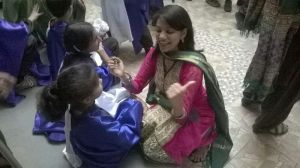A topic that worries parents and teachers alike.Children as young as three years old can understand the basic concepts of good touches, bad touches and confusing touches. These young children can also understand the definition of sexual abuse and are not afraid of the words that send a chill up the spines of adults. Use the words “sexual abuse” when talking with your child because if a child is victimized, they need to be able to tell you that they were “sexually abused!”. As a teacher i feel very strongly that we must treat our young ones as young adults and not cute-fy things unnecessarily.
Inappropriate Touching:
Surveys show that as many as 1 in 4 children have suffered some sort of sexual abuse by the time they reach 18. Statistics show that child sexual abuse crosses boundaries of race, class, culture, ethnicity, gender, and sexuality, affecting all types of communities. What can you do as a parent to help protect your child?
Children today are around more adults on a daily basis than ever before. From childcare to sports practices to dance classes, not to mention camps and after-school programs, children are meeting and interacting with many adults regularly.
That’s why it is so important for parents to talk with their children — as early as age 3 — about inappropriate touching. And children even younger can begin to learn about their bodies.
What is “inappropriate touching”?:
The clinical definition of child sexual abuse is inappropriately exposing or subjecting a child to sexual contact, activity or behavior. An easier way to think of it – and to teach children about it – is by contrasting “good touches” and “bad touches.”
- A good touch can be explained as a way for people to show they care for each other and help each other. Examples you can give include hugging, holding hands, or a parent changing a baby’s diaper.
- A bad touch can be explained as the kind you don’t like and would want to stop right away, such as hitting, kicking or touching private parts.
Before you talk with your child, it’s important that you understand just what “inappropriate touching” means and are comfortable speaking about it. Quite often, the subject of sexual abuse can make parents immediately think, “It’s too awful to think about,” or “That would never happen in our neighborhood/family/school.”
The truth is, sexual abuse cuts across all cultural, racial and economic lines and in most cases the molester is someone the child knows. EVERY parent and teacher should be having this discussion with his or her children. Children are not usually threatened by this information; they embrace it!
- Teach the “Safe Body Rule.” Rather than expect your children to judge a touch only by how it makes them feel (“good” or “bad”), give them a solid rule that they can follow. Using the “Safe Body Rule”, teach them it is NOT okay for anyone to touch their private parts, or what is covered by their swimsuits. It is easier for a child to follow a rule and they will more immediately recognize a “bad touch” if they have this guideline in mind.
- Use proper body names. Sexual predators often take advantage of the fact that we don’t speak freely with our children about sex and our bodies. By talking about genitals and age-appropriate sexual matters to children in a respectful manner, we stop teaching by exclusion that all these things are secret and not to be talked about. One of the most important goals of having this conversation with your child is to let them know that they SHOULD speak up if something happens and should not be embarrassed or scared to talk about their own bodies or of your reaction
- Prepare them to react to a “secret.” Explain that if an adult does something your child thinks is wrong and then tells them to keep it a secret, they should tell you immediately. Giving children specific examples like this will help them feel more empowered to act if necessary. Role-play can be a valuable tool in this step as well.
This video has certainly helped broach this subject with ease,and having played it usually at an interval of two-three weeks in classroom.A discussion on good and bad touch ensues as a by product,and cementing of basic knowledge amongst children


